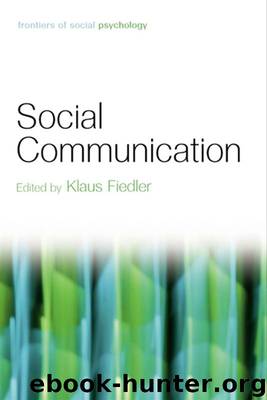Social Communication (Frontiers of Social Psychology) by Unknown

Author:Unknown
Language: eng
Format: mobi
Publisher: Taylor and Francis
Published: 2011-03-14T14:00:00+00:00
8
What is Said and What is Meant: Conversational Implicatures in Natural Conversations, Research Settings, Media, and Advertising
Michaela WÄnke
One day Joe bear was hungry. He asked his friend Irving bird where some honey was. Irving told him there was a beehive in the oak tree. Joe threatened to hit Irving if he didn’t tell him where some honey was. (Schank & Childers, 1984, p. 83; example from the development of TALE-SPIN, a computer program that makes up stories)
A pparently Joe bear did not understand the meaning of the word “beehive”. Needless to say, a lack of semantic understanding makes communication difficult if not impossible. But consider the following example:
At a holiday resort a woman comes to the swimming pool and sits down next to another woman who is intended to strike up a conversation. “Hi”, the neighbour says, “where do you come from?” “From my room”, the new guest replies friendly. “No, I mean where do you live?” “At home, of course”, the woman answers. “But where is ‘home’?” “Oh, you mean, where my house is?” “Yes”, sighs the interrogator with relief, “that’s what I mean”. “Right next to the Jones”.
This example demonstrates that semantic understanding is not sufficient for a successful communication. Given that the goal of communication is to convey meaning, the task of a listener is to understand what the speaker intends to mean. Most often, to understand what is meant requires going beyond the literal meaning of what is said. In other words, listeners have to make inferences in order to arrive at a pragmatic understanding. The need for such pragmatic inferences then of course calls for rules for inferences. Moreover, successful communication requires that all conversation partners share knowledge about these rules. In this respect, shared knowledge about inference rules is part of the “common ground”, which is defined as the information a speaker and an addressee believe they share (Clark & Marshall, 1981; Clark & Schober, 1991). One shared principle from which inference rules may be derived has been expressed by Paul Grice as the cooperative principle when he observed that “our talk exchanges … are characteristically, to some degree at least, a cooperative effort” (1975; p 45). The cooperative principle is the general principle underlying many more specific rules, which govern conversations, and if used as inference rules determine understanding in various social settings. After a detailed discussion of the cooperative principle I will turn to its application as an inference rule in one important domain of social exchange, namely the use and understanding of irony. Interestingly, the application of the cooperative principle as an inference rule is not constrained to natural conversations. The latter part of the present chapter is devoted to inferences in non-natural communication settings. Specifically, I will review how research participants infer the meaning of instructions and research material and what inferences recipients draw from statements in advertising and in media reports.
The Cooperative Principle as A Pragmatic Inference Rule
Joe bear apparently did not only miss the meaning of beehives. His failure went further and caused him to act strangely – at least from a human perspective.
Download
This site does not store any files on its server. We only index and link to content provided by other sites. Please contact the content providers to delete copyright contents if any and email us, we'll remove relevant links or contents immediately.
| Africa | Americas |
| Arctic & Antarctica | Asia |
| Australia & Oceania | Europe |
| Middle East | Russia |
| United States | World |
| Ancient Civilizations | Military |
| Historical Study & Educational Resources |
The Sympathizer by Viet Thanh Nguyen(4277)
The Rape of Nanking by Iris Chang(4116)
World without end by Ken Follett(3406)
Ants Among Elephants by Sujatha Gidla(3377)
Blood and Sand by Alex Von Tunzelmann(3112)
Japanese Design by Patricia J. Graham(3087)
City of Djinns: a year in Delhi by William Dalrymple(2493)
The Queen of Nothing by Holly Black(2451)
Foreign Devils on the Silk Road: The Search for the Lost Treasures of Central Asia by Peter Hopkirk(2414)
Inglorious Empire by Shashi Tharoor(2381)
India's Ancient Past by R.S. Sharma(2379)
Tokyo by Rob Goss(2353)
In Order to Live: A North Korean Girl's Journey to Freedom by Yeonmi Park(2323)
Tokyo Geek's Guide: Manga, Anime, Gaming, Cosplay, Toys, Idols & More - The Ultimate Guide to Japan's Otaku Culture by Simone Gianni(2299)
India's biggest cover-up by Dhar Anuj(2289)
The Great Game: On Secret Service in High Asia by Peter Hopkirk(2271)
Goodbye Madame Butterfly(2184)
Batik by Rudolf Smend(2073)
Living Silence in Burma by Christina Fink(2019)
